There are places where you like to be and where you spontaneously feel at ease. Where you can relax and feel at home. Clonmacnoise on the River Shannon is such a place…
Page Contents (click line to jump the text)
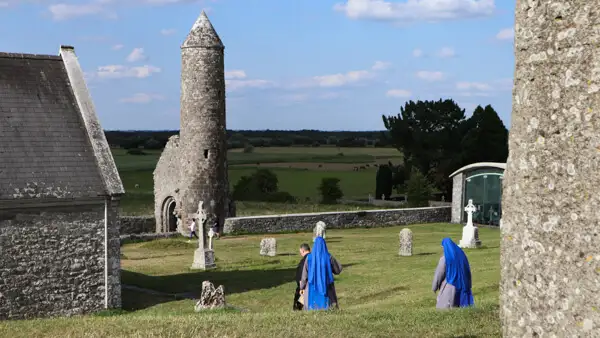
Intro
I’d been on the bike for most of the day, it was late afternoon and I was getting a bit restless inside.
I wanted to see the medieval monastery of Clonmacnoise quickly and then ride on to Galway, where I had booked an overnight stay. It was later than planned and I knew that Clonmacnoise would only be open for just over an hour.
Why did I want to see it? We have a similar site nearby in the Wicklow Mountains, the monastery of Glendalough, and I’m a big fan of it. Clonmacnoise should probably be similar.
Finally arrived at the Shannon – there are houseboats at the jetty…nice! Small car park, a few cars, a few metres on foot, friendly welcome – the inner restlessness was still there.
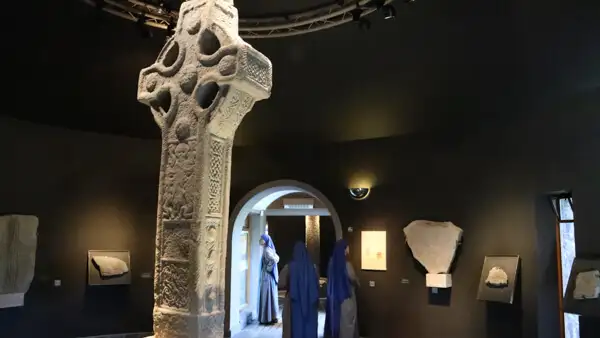
A tour of the exhibition – very nicely done, beautifully crafted Celtic crosses from the early Middle Ages – interest is growing. A group of Spanish nuns are also there and are probably being shown around by a priest.
After the exhibition we go outside – wow, what an atmosphere! The old monastery is situated on a flat hill on the banks of the River Shannon and the landscape and views of the surrounding area are really beautiful. I’m getting a bit more relaxed.
Typical Irish medieval round towers, a few simple monastic buildings made of rough stone and a few ruins, plus more Celtic crosses. The resemblance to Glendalough is definitely there. A similar site and also in a very beautiful setting. I love it!
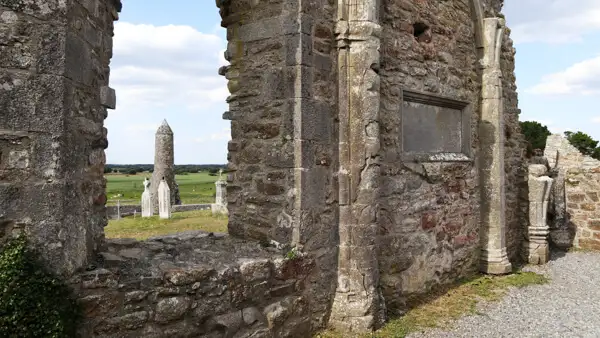
The nuns and I stroll around the beautiful grounds, explore the ruins and take in the surroundings. The tranquillity of the scenery carries over and I am now deeply relaxed.
We stroll around for a while, then we are kindly informed that the complex will be closed for the evening. Never mind, I still have a few minutes.
A quarter of an hour later, I’m back on the motorbike – still completely relaxed. Where do I want to go now? Oh yes, Galway – it’s probably going to be late, never mind. The engine starts and I chug off again – completely relaxed and at peace…
We’re from Germany, by the way, but have been living in Ireland for a few years now (second home).
But let’s get back to the monastery of Clonmacnoise:
Visiting Clonmacnoise Monastic Site
Clonmacnoise is located on the Shannon. From Athlone, you drive a few kilometres downstream, i.e. to the south. Apart from the monastery complex, there is not much here, just a few houses and the river.
There is a small shop at the entrance to the monastery and the dilapidated ruins of Clonmacnoise Castle opposite.
The complex itself is manageable in size and can easily be visited in an hour.
There is a beautiful exhibition of ornate Celtic crosses inside and you can learn about the history and construction of the monastery. The exhibition buildings are made of rough stone in the style of the monastery and blend in very harmoniously with the monastic surroundings.
See: https://heritageireland.ie/places-to-visit/clonmacnoise-monastic-site/.
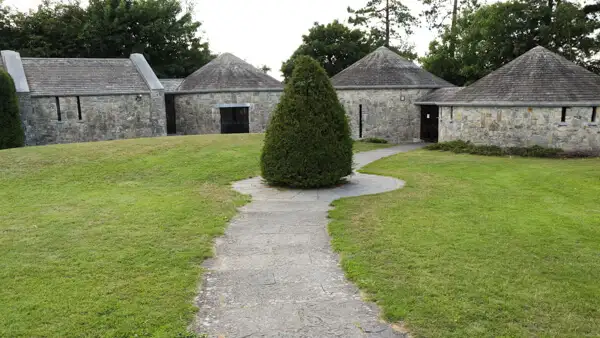
Some background to Clonmacnoise
Clonmacnoise Monastery was founded in the 6th century by St Ciaran, who died young a few years later. The monastery grew steadily and more and more buildings were erected on the site between the 7th and 10th centuries. It is noteworthy that it remained a collection of smaller chapels and churches and was never dominated by a particularly large cathedral. The current collection of buildings therefore comes from different eras and was also built in different styles.
Clonmacnoise grew in size and importance over time. Not only monks lived here, but also many craftsmen, artisans, agricultural labourers and servants. Trade was carried out here and crafts also flourished. Valuable handicrafts were also created in Clonmacnoise, such as ecclesiastical and religious artefacts, which were very popular in Ireland and abroad due to their artistic design.
The monastery reached its peak in the 12th century. If I remember the information boards in the monastery correctly, up to 3000 people lived on the grounds of the monastery and in the immediate vicinity at this time.
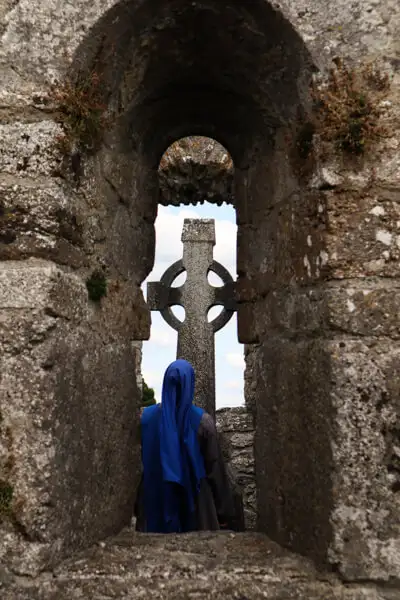
The monastery was one of Ireland’s spiritual centres for several centuries, as was Glendalough Monastery, which I have already mentioned. These important monasteries had the role of universities in the Middle Ages, where students from all over Europe were educated. These were clerical students, but also sons of noble families.
Unfortunately, the monastery was subsequently plundered several times, first by Vikings and then by Anglo-Normans. The round towers, which can also be found in other Irish monasteries, were used to keep valuables and people safe in the event of raids. Two such round towers can be found on the site.
Over a hundred wooden houses were burnt and the monastery never fully recovered. The same Normans built a castle, Clonmacnoise Castle, next to the monastery directly on the river, the remains of which can still be recognised.
The monastery continued to operate on a smaller scale for a while, but was then badly destroyed during Oliver Cromwell’s campaigns in the 17th century and never rebuilt.
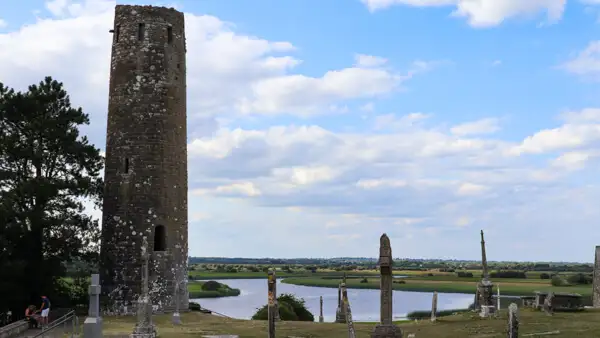
What else you can see in the area
Here are a few tips on what else you can see in the Clonmacnoise area:
Athlone
The city of Athlone on the River Shannon is geographically located in the centre of Ireland and is practically the centre of the Irish Heartlands. I have already written an article about it, which you can find here: https://ireland-insider.com/athlone-in-the-heart-of-ireland/.
Birr Castle
The small town of Birr is located a little to the east of CLonmacnoise. Here you will find a very beautiful castle with marvellous gardens. See: https://birrcastle.com/.
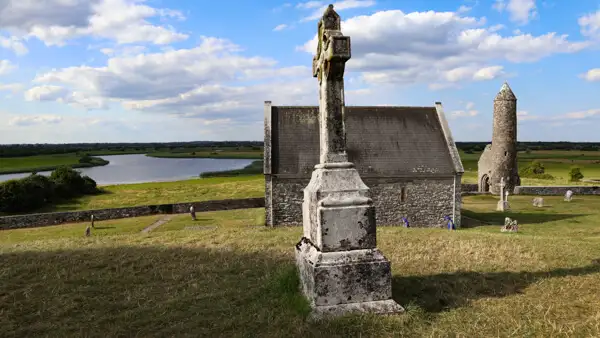
Portumna Castle and Friary
Portumna is a small village on the River Shannon south of Clonmacnoise. There you will find Portumna Castle & Gardens, see: https://heritageireland.ie/places-to-visit/portumna-castle-and-gardens/. Within sight, a few metres further on, you can also see the ruins of the once impressive Portumna Friary.
Lough Derg
Portumna lies on the River Shannon and Lough Derg, which is formed by the River Shannon. This lake is very large and it is worth exploring the shores and going for a walk. You can also do this in Portumna Forest Park, see: https://www.coillte.ie/site/portumna-forest-park/.
Conclusion
The River Shannon lies in the heart of Ireland and offers many beautiful excursion destinations. One of these is the medieval monastery of Clonmacnoise.
Even if you are usually less interested in monasteries (like me) – you will love this one.
Simply enjoy the wonderful location and the relaxed atmosphere on the extensive grounds. The view over the river landscape alone is worth the visit.
You can plan Clonmacnoise into your outward or return journey from the Wild Atlantic Way, or you can take a tour along the Shannon. There are many possibilities…
Have fun in Clonmacnoise on the Shannon
More interesting articles for you
DROMBEG STONE CIRCLE – THE MEGALITHIC HERITAGE OF IRELAND
GLENDALOUGH MONASTIC CITY – A MUST-SEE-PLACE IN IRELAND’S ANCIENT EAST!
BLARNEY CASTLE AND THE STONE OF ELOQUENCE
THE LEGENDARY ROCK OF CASHEL
Picture credits cover picture: Clonmacnoise monastic site at River Shannon, photo: Ulrich Knüppel-Gertberg (www.irland-insider.de, www.ireland-insider.com)